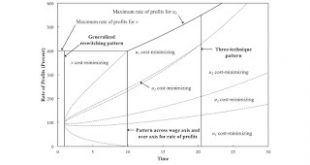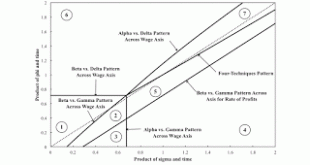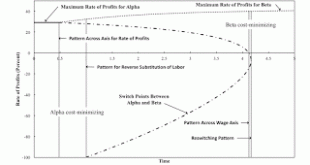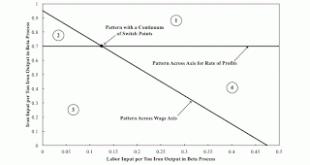Figure 1: Switch Points Varying with Time1.0 Introduction This post presents a perturbation of a fluke switch point. At this switch point, the wage curves for four techniques are tangent. In the jargon I have been inventing, this is another four-technique, local pattern. In other words, a perturbation of appropriately selected parameters - for example, coefficients of production - changes the sequence of wage curves and switch points on the wage frontier. The perturbation can be viewed as...
Read More »Update To A Start On A Catalog Of Switch Point Patterns Of High Co-Dimension
I have been looking at patterns of switch points. A pattern is a configuration of switch points helpful for perturbation analysis for the choice of technique. I am curious how the switch points and the wage curves along the wage frontier can alter with parameters, in a model of the production of commodities. Such a parameter can be a coefficient of production; time, where a number of parameters are functions of time; or the markup in an industry or a number of industries. A normal form...
Read More »One Technique Replacing Another
Figure 1: One Way One Technique Can Replace Another The wage-rate of profits frontier (or wage frontier) is calculated with prices of production, given the techniques of production, available in the economy, for producing a given output. Suppose at one point in time, the techniques that lie along the wage frontier consist of the Alpha, Beta, and Gamma techniques, in order of an increasing rate of profits. As time passes, technical innovation alters coefficients of production, including for...
Read More »Another Way Reswitching Can Appear
Figure 1: Wage Curves for a Reswitching Example1.0 Introduction This post illustrates another fluke case. In this example economy, two techniques exist for producing a net output of corn. The wage curves for the two techniques have two switch points. One switch point is on the wage axis, corresponding to a rate of profits of zero. The other is on the axis for the rate of profits, corresponding to a wage of zero. This example is a fluke in two ways. In the jargon I have been inventing, it...
Read More »A Four-Technique Pattern
Figure 1: Partition of the Parameter Space1.0 Introduction I here provide some notes on a perturbation of an example from Salvadori and Steedman (1988). Consider an economy in which n commodities are produced in n industries. In each industry, a single commodity is produced from inputs of labor and the services of previously produced capital goods. Suppose the technology can be represented in each industry by a continuously-differentiable production function. The wage-rate of profits...
Read More »Start of a Catalogue of Flukes of Fluke Switch Points
I claim that the pattern analysis I have defined can be used to generate additional fluke switch points. I am particularly interested in switch points that are flukes in more than one way (local patterns of co-dimension higher than one) and fluke switch points that are combined with other fluke switch points or some aspect of other switch points (global patterns). I have already generated some examples, not always with pattern analysis. Fluke switch points of higher co-dimension A switch...
Read More »A Pattern For The Reverse Substitution Of Labor
Figure 1: Variation of Switch Points with Time1.0 Introduction This post presents another local pattern of co-dimension one. I have conjectured that only four types of local patterns of co-dimension one exist (a reswitching pattern, a three-technique pattern, a pattern across the wage axis, and a pattern over the axis for the rate of profits). In this conjecture, I meant to implicitly limit the rate of profits at which switch points occur to be non-negative and not exceeding the maximum...
Read More »Perturbation Of An Example With A Continuum Of Switch Points
Figure 1: A Partitioning Of The Parameter Space1.0 Introduction I consider here a case where two different techniques have the same wage curve. A simple labor of theory of value describes prices in the case under consideration. I treat the labor coefficient and another coefficient of production for a process in one technique as parameters. And I look at what happens when they vary. A note on terminology: on the basis of expert advice and peer review, I am no longer using the term...
Read More »Bifurcation Analysis of a Two-Commodity, Three-Technique Technology
Figure 1: A Bifurcation Diagram This post expands on this previous post. The technology is the same, but the rates of decrease of the coefficients of production in the Beta and Gamma corn-producing processes are not fixed. Instead, I consider the full range of parameter values. (I find the graphs produced by bifurcation analysis interesting for this case, but I think a two-commodity example can be found with more pleasing diagrams.) Anyways, Figure 1 shows a bifurcation diagram for the...
Read More »Reswitching Without a Reswitching Bifurcation
Figure 1: A Bifurcation Diagram This post presents another example of bifurcation analysis applied to structural economic dynamics with a choice of technique. This example illustrates: Two reswitching examples appear and disappear without a restitching bifurcation ever occurring, at least on the wage frontier. Two bifurcations over the wage axis arise. At the time each bifurcation of this type occurs, another switch point for the same techniques exhibits a real Wicksell effect of zero....
Read More » Heterodox
Heterodox








